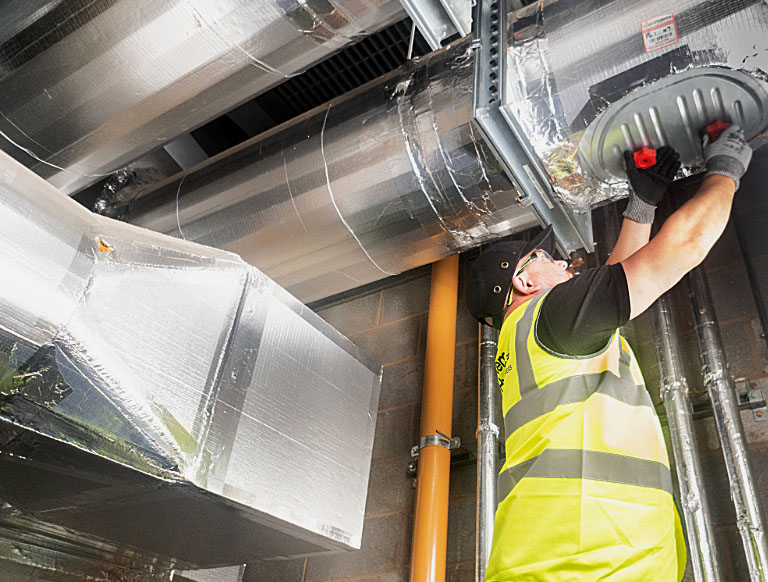What are Fire Dampers?
Learn more about fire dampers, their importance, and why regular testing is needed
.jpg)
Hidden within the ventilation systems of every commercial building, fire dampers work silently to protect lives. Most people never see or think about them - until something goes wrong. Understanding what fire dampers are and why they need regular testing could make the difference between a minor incident and a major disaster.
Understanding Fire Dampers: Your Building's Hidden Heroes
What are Fire Dampers?
Fire dampers are mechanical devices installed in ventilation ductwork where it passes through fire-resistant walls and floors. Think of them as automatic doors that slam shut when fire strikes. In normal conditions, fire damper systems remain open, allowing air to flow freely through your building. But when temperatures rise beyond a certain point, they spring into action, closing to prevent fire and smoke from spreading through the ventilation system.
These devices are absolutely critical in any industrial environment. Without properly functioning fire dampers, your ventilation system becomes a highway for fire and smoke to race through your entire building.
How Fire Dampers Save Lives
When a fire starts, it looks for the easiest paths to spread. Ventilation ducts provide perfect channels for flames and toxic smoke to travel from room to room, floor to floor. Fire dampers block these paths by:
• Automatically closing when exposed to heat (typically at 72°C)
• Creating a barrier that maintains the fire resistance of walls and floors
• Preventing smoke from spreading to escape routes
• Buying precious time for evacuation and fire service response
But here's the crucial point: fire dampers only work if properly maintained and tested.
Types of Fire Dampers in Ductwork
Not all fire dampers are the same. Understanding the different types of fire dampers in ductwork helps building managers ensure they have the proper protection:
Mechanical Fire Dampers
These are the most common type, using a simple but effective mechanism. Mechanical fire dampers contain a thermal element (usually a fusible link) that melts at a specific temperature. When this happens, a spring mechanism snaps the damper closed. They're reliable, cost-effective, and don't require power to operate.
Intumescent Fire Dampers
These dampers use special materials that expand when heat exposure, sealing the duct opening. They're instrumental in smaller ducts or retrofit situations.
Dynamic Fire Dampers
Designed for systems where fans continue running during a fire, these dampers can close against airflow pressure. They're tested to ensure they'll work even with the ventilation system running.
Smoke Dampers
While technically different from fire dampers, they are often combined into fire/smoke dampers that prevent both fire and smoke spread. They can be triggered by smoke detectors and heat.
Why Regular Testing is Non-Negotiable
Here's a sobering fact: on average, nearly 22% of dampers fail during a routine fire and smoke damper inspection. Common problems include:
• Dampers blocked by debris or duct modifications
• Corroded or damaged mechanisms
• Fusible links painted over or replaced incorrectly
• Access panels sealed or blocked
• Incorrect installation from the start
UK regulations require fire dampers to be tested at least annually. This isn't just bureaucracy - it's based on real-world evidence of what happens when dampers fail.
The System Hygienics Approach to Fire Damper Testing
Our comprehensive service ensures your dampers will work when needed most.
Professional Inspection Process:
1. Location and Access: Technicians locate all dampers using building plans and physical inspection
2. Functional Testing: Each damper is physically tested to ensure it closes properly
3. Reset and Clean: Dampers are reset, cleaned, and lubricated as needed
4. Documentation: Every damper is recorded with photos and test results
5. Remedial Works: Any failures are reported with clear recommendations for repairs
When Remedial Works Become Essential
During testing, we often discover dampers requiring remedial works. Common issues include:
• Damaged Blades: Bent or corroded blades that won't seal properly
• Failed Mechanisms: Springs or fusible links that need replacement
• Access Problems: Installing proper access panels for future testing
• Incorrect Installation: Fixing dampers installed backwards or in the wrong locations
• Missing Dampers: Installing dampers where they should have been originally
We don’t just identify these problems – we fix them. Our complete remedial works service means you get everything sorted with one trusted contractor.
The Unique Challenges of Different Environments
Every industrial environment presents unique challenges for fire damper maintenance:
Manufacturing Facilities: Often have large, complex duct systems with dampers in hard-to-reach locations. Dust and debris can interfere with damper operation.
Healthcare Buildings: Require minimal disruption during testing. System Hygienics works around critical areas to maintain essential services.
Commercial Kitchens: Grease buildup can prevent dampers from closing properly. Regular testing is especially important in these high-risk environments.
Office Buildings: Multiple tenancies can make access challenging. System Hygienics coordinates with building management to ensure comprehensive testing.
The Real Cost of Neglect
Failing to maintain fire dampers properly can result in:
• Criminal prosecution under fire safety regulations
• Insurance claims being rejected after a fire
• Tragic loss of life that could have been prevented
• Massive property damage
• Business closure and reputation damage
Compared to these potential consequences, regular testing with us is a small investment that provides enormous protection!

.jpg)
.jpg)
